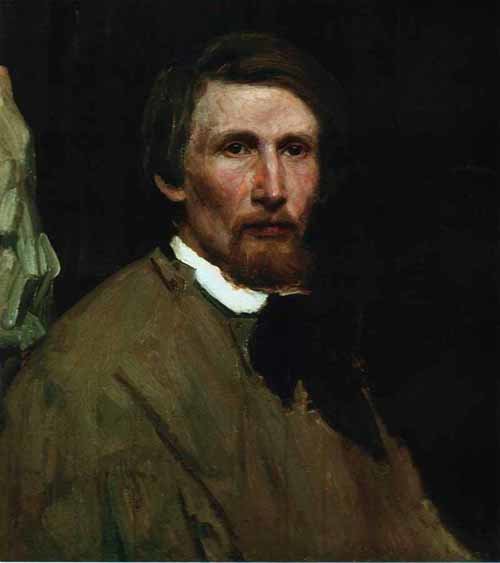Васнецов Виктор Михайлович (3 (15) мая 1848 – 23 июля 1926) - живописец, график, архитектор, иллюстратор. Портретист, монументалист, автор жанровых картин, театральный художник.
Родился в селе Лопьял Вятской губернии. Сын сельского священника Михаила Васильевича Васнецова и Аполлинарии Ивановны. Всего в семье было шестеро детей, в том числе Аполлинарий Васнецов – художник, известный живописными реконструкциями старой, допетровской Москвы.
Первоначальное образование получил в Вятской духовной семинарии. В 1868–1875 годах учился в Петербургской Академии художеств. В 1876 году был в Париже, затем в Италии. С 1874 года постоянно участвовал в выставках передвижников. В 1892 году получил звание академика. Как и многие русские художники того времени, стремился выйти за границы канонов академического искусства.
С 1878 года Васнецов поселился в Москве, где им были написаны самые известные картины и выработана иллюстративно-фольклорная направленность творчества. Современников поражали огромные полотна на исторические темы и темы русских сказок и былин – «После побоища», «Богатыри» и т.д.
Искусство Васнецова порождало острые дискуссии. Многие видели в нем начало нового, истинно национального направления в русской живописи. Но большинство считало его живопись безынтересной, а попытки возродить византийский и древнерусский стили бесплодными. Особые споры возникли после выхода первого номера журнала «Мир искусство» в 1898 году, где также было представлено творчество Васнецова. «Никак я не мог одобрить и то, что в первом же номере, имевшем как-никак значение известного credo наших идеалов и стремлений, половина иллюстраций была посвящена тому художнику, к которому у меня выработалось определенное отрицательное отношение, а именно к Виктору Васнецову» – негодовал А.Н. Бенуа. Чуть позже Михаил Нестеров писал: «Десятки русских выдающихся художников берут свое начало из национального источника – таланта Виктора Васнецова».
Тем не менее, творчество В.М. Васнецова оказало влияние на художников периода модерн и, особенно, на художников Абрамцевского кружка С.И. Мамонтова, одним из организаторов которого и активным участником он был в 1880-х годах. Васнецов исполнил костюмы и декорации для постановок в театре Мамонтова, в 1881 году вместе с В. Поленовым построил церковь в «русском стиле» в Абрамцеве. В дальнейшем он спроектировал и осуществил немало построек: собственный дом и мастерскую в 3-м Троицком переулке (ныне Васнецова), галерею Цветкова на Пречистенской набережной, фасад главного здания Третьяковской галереи в Лаврушинском переулке и т.д.
В 1885-1896 годах принимал участие в работе над росписями Владимирского собора в Киеве. Обращение к религиозной теме им было продолжено в мозаиках для храма Вознесения в Петербурге, росписях и мозаиках храма Рождества Иоанна Предтечи на Пресне и т.д.
Был женат на Александре Владимировне Рязанцевой. Имел сыновей: Бориса, Алексея, Михаила, Владимира и дочь Татьяну.
Умер в Москве в своей мастерской во время работы над портретом. Похоронен на Лазаревском кладбище. Позднее его прах был перенесен на Введенское кладбище Москвы.
Victor Mikhailovich Vasnetsov (May 3 (15) 1848 - July 23, 1926) - painter, graphic artist, architect, illustrator. Portraitist, muralist, author of genre paintings, theater artist.
Born in the village Lopyal, Vyatka province. The son of a village priest Mikhail Vasilievich Vasnetsov and Apollonia Ivanovna. All in the family had six children, including Apollinaris Vasnetsov - artist known for spectacular reconstruction of the old, pre-Petrine Moscow.
Vasnetsov got his basic education in the Vyatka Theological Seminary. In 1868-1875 he studied at the St. Petersburg Academy of Arts. In 1876 he was in Paris, then in Italy. Since 1874 continuously participated in exhibitions Wanderers. In 1892 he received the title of academician. Like many Russian artists of the time, wanted to go beyond the boundaries of the canons of academic art.
Since 1878 Vasnetsov settled in Moscow, where he wrote the most famous paintings and developed illustrative and folk art direction. Struck contemporaries huge canvases on historical subjects and themes of Russian fairy tales and legends - "After the Battle", "Heroes", etc.
Vasnetsov Art rise sharp debates. Many saw it as the beginning of a new, truly national trends in Russian painting. But most found it uninteresting painting, and attempts to revive the Byzantine and ancient styles fruitless. Special disputes arose after the first issue of the magazine "World of Art" in 1898, which was also presented creative Vasnetsov. "No I could not endorse the fact that in the first room, which had, after all, the value of the famous credo of our ideals and aspirations, illustrations half was devoted to the artist, to which I have developed a certain negative attitude, namely Viktor Vasnetsov" - resented AN Benoit. A little later, Mikhail Nesterov wrote: "Dozens of Russian prominent artists originate from national sources - Viktor Vasnetsov talent."
Nevertheless, creativity VM Vasnetsov influenced the artists of the period and modern, especially for artists Abramtsevo circle SI Mamontov, one of the organizers of which he was an active participant in the 1880s. Vasnetsov fulfilled the costumes and sets for productions at the theater Mamontov, in 1881, together with V. Polenov built the church in the "Russian style" in Abramtsevo. Later he designed and implemented a lot of buildings: their own home and workshop in the 3rd Trinity Lane (now Vasnetsov) Tsvetkov gallery on Prechistenskaya waterfront facade of the main building of the Tretyakov Gallery in Lavrushinsky Lane, etc.
In 1885-1896 he participated in the work on the paintings of Vladimir Cathedral in Kiev. Appeal to their religious theme was continued in the mosaics for the church of the Ascension in St. Petersburg, paintings and mosaics of the Nativity of St. John the Baptist in Presnya, etc.
He was married to Alexandra Vladimirovna Ryazantseva. Had sons: Boris, Alexis; Michael; Vladimir and daughter Tatyana.
He died in Moscow in his studio while working on the portrait. He was buried at the Lazarevsky cemetery. Later his remains were moved to the Vvedenskoe cemetery in Moscow.




















.%20%D0%9C%D0%BE%D1%81%D0%B3%D0%BE%D1%80%D0%BD%D0%B0%D1%81%D0%BB%D0%B5%D0%B4%D0%B8%D0%B5.jpg&w=1920&q=75)














